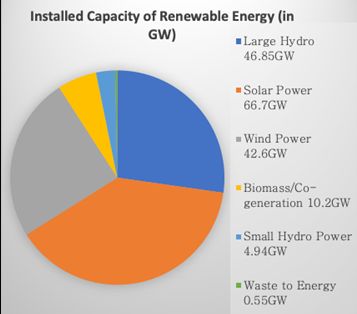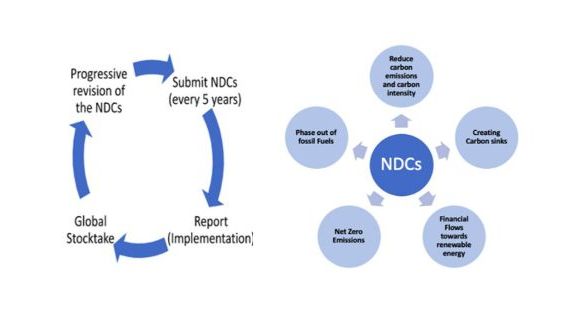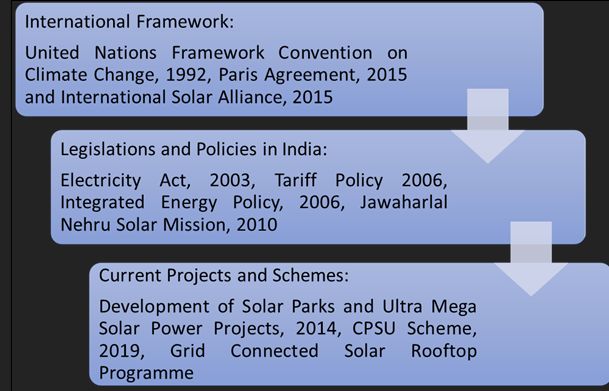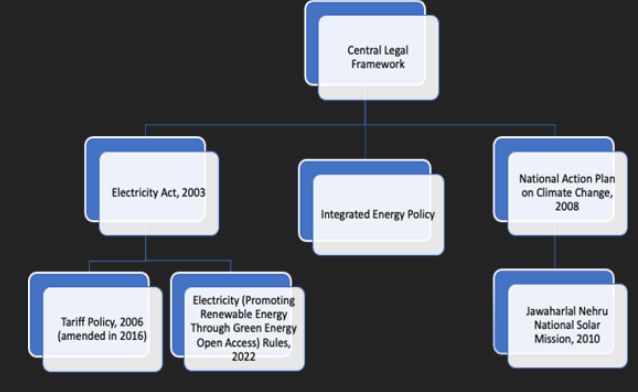INTRODUCTION
As per the report on World Energy Outlook 2021 of the International Energy Agency (IEA), the then-current share of India in the global primary energy consumption was 6.1% and is likely to increase to about 9.8% understated policies scenarios by 2050. India's dependence on coal, oil, and natural gas as a source of energy is projected to grow as a result of this increase in demand for power. But not only will domestic coal production and oil imports fall short of meeting demand, they will also have an adverse impact on the environment and the economy. One of the ways India can improve its energy security in the face of rising demand is by increasing the number of solar power units and its reliance on solar energy.
The Government has also announced its aim of achieving 500 GW installed capacity from the non-fossil fuel-based capacity (Hydro, Nuclear, Solar PV, Wind, Biomass, etc.) by 2030. Towards achieving its aim, India has set its sight to further harness the power of the sun. With its abundant sunlight resources, the country has embarked on a remarkable journey towards expanding solar power generation and shaping a brighter, greener future. In recent years, India has made significant strides in adopting solar energy on a large scale. The nation's commitment to solar energy was underpinned by the launch of the ambitious Jawaharlal Nehru National Solar Mission in 2010.

Source: National Investment Promotion and Facilitation Agency (India), February 20231
This article seeks to provide an overview with respect to the growth of solar power in India and identify the growth factors.
INTERNATIONAL FRAMEWORK
UNFCCC and the Paris Agreement
The United Nations Framework Convention on Climate Change secretariat (UN Climate Change) is the United Nations entity tasked with supporting the global response to the threat of climate change. The United Nations Framework Convention on Climate Change (UNFCCC) was signed in 1992 at the United Nations Conference on Environment and Development, also called the 'Earth Summit'.
The UNFCCC is the parent treaty of the Paris Agreement. The Paris Agreement (also known as the Conference of Parties 21 or COP 21) was adopted by 196 Parties at the UN Climate Change Conference in Paris, France, on 12 December 2015. The Agreement includes commitments from all countries to reduce their emissions and work together to adapt to the impacts of climate change and calls on countries to strengthen their commitments over time. Its overarching goal is to hold "the increase in the global average temperature to well below 2°C above pre-industrial levels" and pursue efforts "to limit the temperature increase to 1.5°C above pre-industrial levels."
The Agreement provides a framework for open monitoring and reporting of the climate goals of the participating countries while giving wealthier nations a method to support developing countries in mitigating and adapting climate change.
Nationally Determined Contributions

According to the Paris Agreement, countries must take progressively ambitious climate action over a five-year period. Every country is required to submit an updated Nationally Determined Contribution (NDC), also known as a national climate action plan, every five years.
Countries outline the steps they will take in their NDCs to reduce their greenhouse gas emissions in order to achieve the purpose of the Paris Agreement. Additionally, nations outline in their NDCs the steps they will take to strengthen their capacity for adaptation to the effects of global warming.
The first "global stocktake" will evaluate the Paris Agreement goals in December 2023. This procedure is intended to provide nations with more motivation to adopt aggressive climate change measures to keep global warming below 1.5 degrees Celsius.
India NDCs
India submitted its Intended Nationally Determined Contribution (NDC) to the United Nations Framework Convention on Climate Change (UNFCCC) on 2nd October 2015. In the 26th session of the Conference of the Parties to the UNFCCC, the Panchamrit action plan was presented by the Government of India towards its commitment to climate action, This was then revised in August 2022, and the main submissions include2:
- To reduce the Emissions Intensity of its GDP by 45% by 2030, from the 2005 level.
- To achieve about 50% cumulative electric power installed capacity from non-fossil fuel-based energy resources by 2030, with the help of the transfer of technology and low-cost international finance, including from the Green Climate Fund.
- To create an additional carbon sink of 2.5 to 3 billion tonnes of CO2 equivalent through additional forest and tree cover by 2030.
International Solar Alliance
The International Solar Alliance (ISA) was launched as a joint effort by India and France at the United Nations Climate Change Conference in 2015 in Paris (COP 21). It is a platform that works to create and implement solar-powered energy solutions to assist member states in pursuing low-carbon growth trajectories. The ISA is focused particularly on Least Developed Countries and the Small Island Developing States.
The ISA is driven by its "Towards 1000" strategy, which seeks to mobilize USD 1,000 billion of investments in solar energy solutions by 2030 while delivering electricity access to 1,000 million people using clean energy solutions and resulting in the installation of 1,000 GW of solar energy capacity.

FRAMEWORK IN INDIA
By the late 2000s, there was growing pressure on the Indian Government to take action to mitigate climate change at several international forums. Renewable energy sources did not contribute much to the whole energy industry, which was run mostly on coal as a fuel source.
The solar sector attracted increasing attention from policy circles due to its potential to advance the industry, create jobs, and downward trends in harnessing solar electricity.
A mission-based drive for the solar sector made sense for policymakers when they combined these concerns and interests with India's ongoing energy shortfall and dependence on imports.
The energy policy of India is primarily shaped to ensure energy security and self-sufficiency.
Legal framework

- Electricity Act, 2003
This legislation aims to transform the power sector in the country and to consolidate laws relating to the generation, transmission, and distribution of energy throughout the country. It seeks to encourage the growth of the electric sector, the provision of energy to all areas, particularly rural ones, and the rationalization of the tariff. This act gave the Central Government the power to work with the State Governments to create policies affecting electricity production.
The Ministry of Power, under the provisions of the Electricity Act, 2003 notified the Electricity (Promoting Renewable Energy Through Green Energy Open Access) Rules, 2022 to further accelerate the renewable energy programs with the objective of ensuring access to affordable, reliable, sustainable and green energy for all. The Rules are also in line with the Commitment of India to cut emissions by 45% by 2030.
These Rules have been amended on January 27, 2023, to enable small consumers to purchase renewable power. The limit for an Open Access transaction has been reduced from 1MW to 100 kW.
The Rules empower the customers to demand a supply of Green Power from Discoms, making it the obligation of Discoms to procure and supply such green power, along with RPO for all entities in the area of distribution licensees. The promotion of open access is also done by providing Green Certificates to consumers of such green power.
- Tariff Policy, 2006
This policy was developed keeping in mind the framework laid down under the Electricity Act of 2003. The Central Electricity Authority and the State Governments were consulted for evolving this policy. The policy aims to ensure the financial viability of the sector and attract investments. The policy also seeks to promote competition, efficiency and improve the quality of supply in the electricity sector.
The policy was further amended in January 2016, and the concept of Renewable Purchase Obligation ('RPO') was introduced. Under the RPO, the appropriate Commission shall fix a minimum percentage of the total consumption of electricity in the area from renewable energy sources. This amendment added certain objectives to the original Tariff Policy as more focus was given to renewables and Hydropower to facilitate an adequate and uninterrupted supply of electricity to consumers.3
- Integrated Energy Policy, 2006
This policy came into force in August of 2006 and focused on all facets of energy in the nation, including energy security, availability, affordability, and environmental implications.
With respect to solar energy, it required power regulators to seek alternative incentive structures that encourage utilities to integrate solar and other renewable energy sources like wind, small hydro, and so on into their systems, and to mandate feed-in laws for solar energy as provided under the Electricity Act 2003.4
- National Action Plan on Climate Change (NAPCC) 2008
India, in collaboration with the United Nations, launched the National Action Plan on Climate Change in 2008. It aimed to address the critical issues of climate change.
The Jawaharlal Nehru National Solar Mission (JNNSM), which sought to increase the proportion of solar energy in the nation's overall energy mix, was one of NAPCC's most effective strategies. The JNNSM also sought to start significant R&D projects to develop more practical and inexpensive solar systems with allowances for long-term storage alternatives.5
- Jawaharlal Nehru National Solar Mission, 2010
To promote ecologically sustainable growth and solve the issues of energy security and energy poverty, the Central Government launched the Jawaharlal Nehru National Solar Mission. The primary goal of this mission is to make India a solar energy pioneer on a worldwide scale. The mission used a three-phase strategy over ten years, with goals set for each phase based on the performance of the prior phase and any advancements in solar energy technology.6
Under the JNNSM, several programs and policies have been implemented to achieve the goals set for increasing solar power. The MNRE launched the idea of solar cities under the guidance of the Indian Government in 2020. These solar cities aim to reduce the projected demand for currently employed conventional energy sources by around 10%. So far, 27 states have identified their cities which can be developed as solar cities.3
Development of solar parks has also been initiated wherein solar parks will be developed in regions with a solar capacity of over 500 MW supported by appropriate funding by the Government to develop the necessary infrastructure.7
The Government has also implemented the Scheme of awarding
concessional customs duty certificates as a financial incentive to
developers for developing grid-connected solar power
plants.8
The measures undertaken under this mission to promote renewable
energy and power include:
- Permitting Foreign Direct Investment (FDI) up to 100 percent under the automatic route;
- Waiver of Inter-State Transmission System (ISTS) charges for inter-state sale of solar and wind power for projects to be commissioned by 30th June 2025;
- Declaration of trajectory for Renewable Purchase Obligation (RPO) up to the year 2029-30;
- Notification of standards for deployment of solar photovoltaic systems/devices;
- Standard Bidding Guidelines for tariff-based competitive bidding process for procurement of Power from Grid Connected Solar photovoltaic systems and Wind Projects;
- State-specific Solar Policies:
Some States introduced their State-specific solar policy to encourage and promote solar energy. Gujarat was the first state to introduce a solar policy in 2009 to promote the generation of clean and green power using solar energy and put in place an appropriate investment environment.
Several States have now made such policy announcements since 2009. After the Indian Government announced the JNNSM in 2010, Karnataka and Rajasthan followed suit in 2011; similarly, Andhra Pradesh, Chattisgarh, Madhya Pradesh, Punjab, and Tamil Nadu announced their solar policies in 2012, which were then followed by Jammu and Kashmir, Jharkhand, Kerala, Uttar Pradesh, and Uttarakhand in 2013 followed by Telangana in 2015.
CURRENT SOLAR PROJECTS AND SCHEMES:
- Development of Solar Parks and Ultra-Mega Solar Power Projects
This Scheme was introduced in 2014 to facilitate solar project developers to establish their projects with speed and efficiency. Under the Scheme, it was proposed to set up at least 25 Solar Parks and Ultra Mega Solar Power Projects targeting 20,000 MW of solar power installed capacity within 5 years starting from 2014-15.
The capacity of the Scheme was enhanced from 20,000 MW to 40,000 MW on 21-03-2017. These parks are proposed to be set up by 2023-24.
Under the Scheme, the Ministry provides Central Financial Assistance (CFA) of up to Rs. 25 lakhs per solar park to prepare a Detailed Project Report (DPR). Besides this, CFA of up to Rs. 20.00 lakh per MW or 30% of the project cost, including Grid-connectivity cost, whichever is lower, is also provided for achieving the milestones prescribed in the Scheme.10
- CPSU Scheme for Setting up 12,000 MW grid-connected Solar Photovoltaic Projects
The objective of this Scheme is to set up solar PV projects through Government Producers using domestic cells & modules in WTO compliant manner to facilitate national energy security and environmental sustainability for Government purposes.
The Government offers support of VGF of up to Rs. 70 lakhs/ MW; actual VGF decided through bidding for VGF required.
- Grid Connected Solar Rooftop Programme
This Scheme aims to achieve a cumulative installed capacity of 40,000 MW from Grid Connected Rooftop Solar (RTS) projects. Under the Scheme, Central Financial Assistance (CFA)/Subsidy is provided to the residential electricity consumers under Component-A, and incentives are provided to DISCOMs under Component B of this program. The period of this Scheme is till 2026.
- Pradhan Mantri Kisan Urja Suraksha Utthaan Mahabhiyaan
With a total central financial support of Rs. 34,422 Crore, including service fees to the implementing agencies, the project seeks to increase solar and other renewable capacities by 30,800 MW by 2022. The three elements of the Scheme are as follows:
10,000 MW of solar capacity will be added through component A's installation of small solar power plants, each with a capacity of up to 2 MW. Installation of 20 lakh independent solar-powered agriculture pumps is Component B. Solarization of 15 lakh grid-connected agricultural pumps is Component C.
ISSUES ASSOCIATED WITH SOLAR POWER GENERATION IN INDIA
- Season-wise Direct Normal Irradiance (DNI) in India
In India, there are primarily four seasons per year: summer, monsoon, winter, and spring. When environmental and geographic factors change, the sun irradiance also varies. In India's central and southern regions, solar irradiation is at its peak in winter. During the spring, the irradiance is uniform throughout India, except in the upper northern and northeastern regions. The irradiance is determined to be average during the summer, ranging between 5-3.5 kW/m2/day and 5-4 kW/m2/day throughout all of India.11
The solar irradiance's fluctuation behavior has impacted the production of solar power. In India, solar power generation varies according to the season. Hence energy storage technologies are needed to ensure a consistent supply of solar electricity throughout the year.
- Energy storage
Only 6 to 8 hours a day on average of solar power are available in India. Factors like dust buildup, cloud coverage, and other weather-related events can cause considerable variations in solar power production. Energy storage assumes the primary role in any power sector for sustaining the power supply from the solar power plant. The use of energy storage devices is projected to increase significantly due to the rapid growth of the renewable energy sector in India.
In India, integrating suitable energy storage with solar systems can ease grid stress by making solar electricity dispatchable. To size solar photovoltaic systems for off-grid solar power connections, energy storage can be crucial. Storage systems can also offer the reactive power support needed to raise the quality of the electricity.
- Availability of Land
Finding an adequate area that is free of agriculture, undeveloped, and has good solar irradiation is difficult. It must be devoid of trees and undulations. Additionally, the next issue with setting up the solar power plant is land acquisition. The land requirement also varied for different technologies used for solar power generation.
ROAD AHEAD
Technological innovation
Conventional methods for producing solar power involve absorbing sunlight by a molecule and converting it directly into electricity. This is possible only when sunlight is available. Methods to store solar energy by converting it to other forms could solve a few challenges associated with harnessing solar power.
An interesting and complementary prospect is storing the absorbed solar energy by converting it into a different form of energy, such as chemical energy, which can then be transformed into electrical energy when sunlight is not available during the night time. To realize this prospect, Assistant Professor Dr. Baswanth Oruganti from the Department of Chemistry has designed a molecule that can absorb solar energy and convert it into the chemical energy of the bonds.
[Source: SRM University, Andhra Pradesh, Thursday, 22 September 2022/published in Chemistry-News, Departmental News, Research News]
The contractual matrix for the development of solar projects should provide an enabling environment for the introduction of new technological advancements.
Encourage the use of novel applications
Every tiny contribution to harnessing solar power would go a long way to achieve India's commitments under the Paris Agreement to tackle climate change.
For example, Surya Nutan, an indigenous indoor solar cooking system design, was developed and patented by Indian Oil Corporation Limited, R&D Centre. Surya Nutan is a stationary, rechargeable, and always kitchen-connected indoor cooking solution capable of catering to the cooking needs of Indian households.
Surya Nutan collects energy from Sun, and converts it into heat through a specially designed heating element; then, this thermal energy gets stored in a scientifically proven thermal battery and recovered for use in cooking (indoor)
A conducive environment for the large-scale use of such novel applications would be very helpful.
[Source: Surya Nutan – An Indoor Solar Cooking System by IndianOil, available at: https://iocl.com/pages/SuryaNutan (last accessed on June 9, 2023).]
Financing and Incentives
Foreign equity financing is prevalent in the solar energy sector in India. Building a conducive environment for enabling non-recourse project financing for solar projects in India would be a big step forward.
Under the Budget 2023, the concept of sovereign Green Bonds has been introduced in order to mobilize resources for green infrastructure while INR 19,5000 crore has been allocated for Production Linked Incentive for manufacturing high-efficiency modules as well in order to achieve the goal of 280 GW of installed solar capacity by 2030.
Footnotes
1. M. Goel, Solar rooftop in India: policies, challenges and outlook, Green Energy & Environment 1 (2) (2016) 129–137.
2. N. Saxena, Solar energy as renewable energy systems: perspective and challenges in the Indian context, Int. J. Eng. Technol. Sci. Res. 5 (1) (2018)
3. Tariff Policy, Ministry of Power, Government of India, (2006) https://powermin. nic.in/sites/default/files/webform/notices/Tariff_Policy-Resolution_Dated_ 28012016.pdf
4. Planning Commission, Government of India, https://planningcommission.nic.in/ reports/genrep/intengpol.pdf
5. National Action Plan on Climate Change, Government of India, Prime Minister's Council on Climate Change. http://www.moef.nic.in/downloads/home/Pg01-52. pdf.
6. Jawaharlal Nehru National, Solar Mission Policy Document, Ministry of New & Renewable Energy, 2012, https://mnre.gov.in/file-manager/UserFiles/draftjnnsmpd-2.pdf.
7. S.K. Suman, J. Ahamad, Solar energy potential and future energy of India: An Overview, Int. J. Eng. Sci. (2018) 17575.
8. Ministry of New and Renewable Energy, Government of India https://mnre.gov.in/ scheme-documents.
9. United Nations Framework Convention on Climate Change https://unfcc.int/news/ international-solar-alliance-enters-into-force.
10. Ministry of New and Renewable Energy, https://mnre.gov.in/solar/schemes/.
11. India Solar Resource Map: Solar Energy Centre, Ministry of New and Renewable Energy, Government of India. Available: 〈http://mnre.gov.in/sec/solarassmnt.htm〉.
12. Raghuwanshi S, Arya R, Renewable energy potential in India and future agenda of research, International Journal of Sustainable Engineering, 2019.
13. Rehman S, Hussain Z Renewable energy governance in India: challenges and prospects for achieving the 2022 energy goals, Journal of Resources, Energy, and Development. 14(1):13–22., (2019)
14. Hemani Paliwal, Green Energy Sources in India: Current Status and Future Potential, International Journal of Engineering, 2021.
The content of this article is intended to provide a general guide to the subject matter. Specialist advice should be sought about your specific circumstances.


